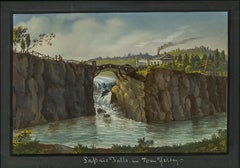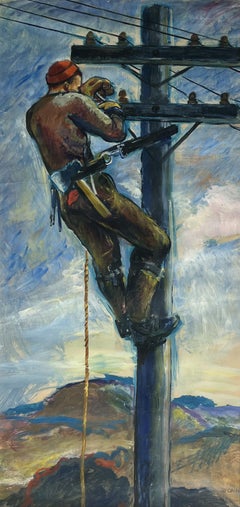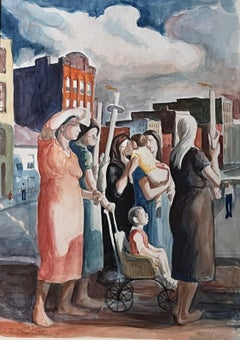Nicolino V. Calyo Art
to
1
1
1
Overall Height
to
Overall Width
to
1
1
1
1
1
1
1
1
1
6,910
3,230
2,514
1,217
1
1
1
1
Artist: Nicolino V. Calyo
Passaic Falls in New Jersey
By Nicolino V. Calyo
Located in New York, NY
Nicolino Calyo's career reflects a restless spirit of enterprise and adventure. Descended in the line of the Viscontes di Calyo of Calabria, the artist was the son of a Neapolitan army officer. (For a brief biographical sketch of the artist see Philadelphia Museum of Art, Pennsylvania, Philadelphia: Three Centuries of American Art, exhib. cat. [1976], pp. 299-301 no. 257.) Calyo received formal training in art at the Naples Academy. His career took shape amidst the backdrop of the political turbulence of early nineteenth-century Italy, Spain, and France. He fled Naples after choosing the losing side in struggles of 1820-21, and, by 1829, was part of a community of Italian exiles in Malta. This was the keynote of a peripatetic life that saw the artist travel through Europe, to America, to Europe again, and back to America.
Paradoxically, Calyo’s stock-in-trade was close observation of people and places, meticulously rendered in the precise topographical tradition of his fellow countrymen, the eighteenth-century
vedute painters Antonio Canale (called Canaletto) and Francesco Guardi. In search of artistic opportunity and in pursuit of a living, Calyo left Malta, and, by 1834, was in Baltimore, Maryland. He advertised his skills in the April 16, 1835 edition of the Baltimore American, offering "remarkable views executed from drawings taken on the spot by himself, . . . in which no pains or any resource of his art has been neglected, to render them accurate in every particular" (as quoted in The Art Gallery and The Gallery of the School of Architecture, University of Maryland, College Park, 350 Years of Art & Architecture in Maryland, exhib. cat. [1984], p. 35). Favoring gouache on paper as his medium, Calyo rendered faithful visual images of familiar locales executed with a degree of skill and polish that was second nature for European academically-trained artists. Indeed, it was the search for this graceful fluency that made American artists eager to travel to Europe and that led American patrons to seek out the works of ambitious newcomers.
On June 16, 1835, the Baltimore Republican reported that Calyo was on his way north to Philadelphia and New York to paint views of those cities. Calyo arrived in New York, by way of Philadelphia, just in time for the great fire of December 1835, which destroyed much of the downtown business district. He sketched the fire as it burned, producing a series of gouaches that combined his sophisticated European painting style with the truth and urgency of on-the-spot observation. Two of his images were given broad currency when William James Bennett reproduced them in aquatint. The New-York Historical Society owns two large Calyo gouaches of the fire, and two others, formerly in the Middendorf Collection, are now in the collection of Hirschl & Adler Galleries. From 1838 until 1855, Calyo listed himself variously in the New York City directories as a painter, a portrait painter, and as an art instructor, singly, and in partnership with his sons, John (1818-1893) and later, the younger Hannibal (1835-1883). Calyo also attracted notice for a series of scenes and characters from the streets of New York, called Cries of New York. These works, which were later published as prints, participate in a time-honored European genre tradition. Calyo’s New York home became a gathering place for European exiles, including Napoleon III. Between 1847 and 1852 Calyo exhibited scenes from the Mexican War and traveled from Boston to New Orleans with his forty-foot panorama of the Connecticut River. Later, he spent time in Spain as court painter to Queen Maria Christina, the result of his continuing European connections, but he was back in America by 1874, where he remained until his death.
The Passaic River rises in the hills just south of Morristown, New Jersey, marking a serpentine eighty-mile course before it empties into Newark Bay. It flows north-northeast to Paterson, where it falls seventy feet in a spectacular cataract before continuing south through Passaic and Newark. William Gerdts, in Painting and Sculpture in New Jersey (1964, pp. 51-2), describes the falls as:
the most important [landscape] subject in New Jersey during the eighteenth and nineteenth centuries. . . . The Passaic Falls remained a popular spot, particularly during the romantic period. Indeed, newspapers, periodicals, and gift books contain many accounts of visits to the Falls, sentimental poems written about them or about a loved one visiting the Falls, or even, occasionally, in memory of one who perished in the waters of the Falls — usually intentionally. . . . Waterfalls . . . were popular among travelers in the period and the Passaic Falls were only surpassed by Niagara Falls and Trenton Falls...
Category
19th Century American Realist Nicolino V. Calyo Art
Materials
Paper, Gouache
Related Items
Man Working Mid 20th Century American Scene Social Realism Industrial WPA Modern
By Jo Cain
Located in New York, NY
Man Working Mid 20th Century American Scene Social Realism Industrial WPA Modern
Jo Cain (1904 - 2003)
Telephone Pole Worker
38 1/4 x 18 1/2 inches
Oil on pap...
Category
1930s American Realist Nicolino V. Calyo Art
Materials
Paper, Gouache
"Going to the Festival" WPA Ashcan 20th Century American Scene Modern Realism
By Daniel Ralph Celentano
Located in New York, NY
"Going to the Festival" WPA Ashcan 20th Century American Scene Modern Realism
Daniel Celentano (1902 - 1980) "Going to the Festival," 14 1/2 x 10 1/2. Watercolor on paper, c. 1930s....
Category
1930s American Realist Nicolino V. Calyo Art
Materials
Paper, Watercolor
1960s "Mountain Side" Watercolor Landscape California Gold Country Mid Century
Located in Arp, TX
Thelma Corbin Moody
AbEx Mountain Side
c. 1960's
Watercolor on Arches Paper
29.5" x 22", Unframed
Thelma Corbin Moody (1908-1986) of Modesto, CA....
Category
Late 20th Century American Realist Nicolino V. Calyo Art
Materials
Watercolor, Paper
“The Lobstermen”
By Gordon Grant
Located in Southampton, NY
Beautiful original watercolor and gouache on archival paper by the famous American marine artist, Gordon Grant. The artwork depicts two rugged lobstermen bringing their catch ashore...
Category
1930s American Realist Nicolino V. Calyo Art
Materials
Gouache, Watercolor, Archival Paper
"Sleigh Ride, Winter, " Fletcher Martin, Woodstock, Holiday Scene Illustration
By Fletcher Martin
Located in New York, NY
Fletcher Martin (1904 - 1979)
Sleigh Ride, Woodstock, New York circa 1955
Watercolor on paper
14 x 11 inches
Signed lower right
Provenance:
James Cox Galler...
Category
1950s American Realist Nicolino V. Calyo Art
Materials
Paper, Watercolor
TOBACCO ROAD Mid 20th Century Realism 1940 Drawing from the Novel WPA Literary 2
By David Fredenthal
Located in New York, NY
TOBACCO ROAD Mid 20th Century Realism 1940 Drawing from the Novel WPA Literary 2
10 1/2 x 6 (sight), Signed David Fredenthal lower right. Framed by Lowy....
Category
1930s American Realist Nicolino V. Calyo Art
Materials
Paper, Ink, Watercolor
H 21 in W 16 in D 2 in
Surveyors WPA American Scene Mid 20th Century Modern Social Realism Men Working
By Jo Cain
Located in New York, NY
Surveyors WPA American Scene Mid 20th Century Modern Social Realism Men Working
Jo Cain (1904 - 2003)
Surveyors
30 ½ x 40 ¼ inches (sight)
Gouache on paper c. 1930s
Signed lower rig...
Category
1930s American Realist Nicolino V. Calyo Art
Materials
Gouache, Paper
Large Watercolour of Pleasure Boats Moored on the River in Florida by USA Artist
Located in Preston, GB
Large Watercolour of Pleasure Boats Moored on the River in Florida by USA Artist David Coolidge AWS (American 20th-21st Century)
Art measures 40 x 30 i...
Category
Late 20th Century American Realist Nicolino V. Calyo Art
Materials
Paper, Watercolor
Original Painting New Yorker Mag Cover proposal. Army Wedding American Scene WPA
By Antonio Petruccelli
Located in New York, NY
Original Painting New Yorker Mag Cover proposal. Army Wedding American Scene WPA
Antonio Petruccelli (1907 – 1994)
Army Wedding
New Yorker cover proposal, c. 1939
11 1/2 X 8 inches ...
Category
1930s American Realist Nicolino V. Calyo Art
Materials
Board, Gouache
Mobile Home with Honda - original watercolor, 1974
Located in Burlingame, CA
Mobile Home with Honda - watercolor is 9 3/4 x 21 1/4 inches. Artist signed, titled and dated. Condition is excellent.
James Torlakson, an international...
Category
20th Century American Realist Nicolino V. Calyo Art
Materials
Archival Paper, Watercolor
Bronx Post Office Mural Study WPA Horse Social Realism Mid 20th Century Modern
By Jo Cain
Located in New York, NY
Bronx Post Office Mural Study WPA Horse Social Realism Mid 20th Century Modern
Jo Cain (1904 - 2003)
Couriers of History Bronx Post Office Mural Study
Horse in the Sun (with two ad...
Category
1930s American Realist Nicolino V. Calyo Art
Materials
Ink, Gouache, Board
Industrial Man Working Mid 20th Century American Scene Social Realism Modern WPA
By Jo Cain
Located in New York, NY
Industrial Man Working Mid 20th Century American Scene Social Realism Modern WPA
Jo Cain (1904 - 2003)
Hammering Nails
39 x 50 ½ inches
Gouache on paper c. 19...
Category
1930s American Realist Nicolino V. Calyo Art
Materials
Paper, Gouache
Previously Available Items
Wigwam of Indians in Canada
By Nicolino V. Calyo
Located in New York, NY
Nicolino Calyo's career reflects a restless spirit of enterprise and adventure. Descended in the line of the Viscontes di Calyo of Calabria, the artist was the son of a Neapolitan army officer. (For a brief biographical sketch of the artist see Philadelphia Museum of Art, Pennsylvania, Philadelphia: Three Centuries of American Art, exh. cat. [1976], pp. 299-301 no. 257.) Calyo received formal training in art at the Naples Academy. His career took shape amidst the backdrop of the political turbulence of early nineteenth-century Italy, Spain, and France. He fled Naples after choosing the losing side in struggles of 1820-21, and, by 1829, was part of a community of Italian exiles in Malta. This was the keynote of a peripatetic life that saw the artist travel through Europe, to America, to Europe again, and back to America.
Paradoxically, Calyo’s stock-in-trade was close observation of people and places, meticulously rendered in the precise topographical tradition of his fellow countrymen, the eighteeenth-century vedute painters Antonio Canale (called Canaletto) and Francesco Guardi. In search of artistic opportunity and in pursuit of a living, Calyo left Malta, and, by 1834, was in Baltimore, Maryland. He advertised his skills in the April 16, 1835 edition of the Baltimore American, offering "remarkable views executed from drawings taken on the spot by himself, . . . in which no pains or any resource of his art has been neglected, to render them accurate in every particular" (as quoted in The Art Gallery and The Gallery of the School of Architecture, University of Maryland, College Park, 350 Years of Art & Architecture in Maryland , exh. cat. [1984], p. 35). Favoring gouache on paper as his medium, Calyo rendered faithful visual images of familiar locales executed with a degree of skill and polish that was second nature for European academically-trained artists. Indeed, it was the search for this graceful fluency that made American artists eager to travel to Europe and that led American patrons to seek out the works of ambitious newcomers.
On June 16, 1835, the Baltimore Republican reported that Calyo was on his way north to Philadelphia and New York to paint views of those cities. Calyo arrived in New York, by way of Philadelphia, just in time for the great fire of December 1835, which destroyed much of the downtown business district. He sketched the fire as it burned, producing a series of gouaches that combined his sophisticated European painting style with the truth and urgency of on-the-spot observation. Two of his images were given broad currency when William James Bennett reproduced them in aquatint. The New-York Historical Society owns two large Calyo gouaches of the fire, and two others, formerly in the Middendorf Collection, are now in the collection of Hirschl & Adler Galleries. From 1838 until 1855, Calyo listed himself variously in the New York City directories as a painter, a portrait painter, and as an art instructor, singly, and in partnership with his sons, John (1818-1893) and later, the younger Hannibal (1835-1883). Calyo also attracted notice for a series of scenes and characters from the streets of New York, called Cries of New York. These works, which were later published as prints, participate in a time-honored European genre tradition. Calyo’s New York home became a gathering place for European exiles, including Napoleon III. Between 1847 and 1852 Calyo exhibited scenes from the Mexican War and traveled from Boston to New Orleans with his forty-foot panorama of the Connecticut River. Later, he spent time in Spain as court painter to Queen Maria Christina, the result of his continuing European connections, but he was back in America by 1874, where he remained until his death.
The present work is one of a series of small-size gouaches that gives evidence of a trip that the artist made to the Canada-New York border. Wigwam of Indians, in Canada is a rarity in the Calyo oeuvre, a close-up landscape view with only the faintest glimpse of sky. (The light source for the image comes from the upper left-hand corner shining faintly through the trees.) The artist seems to have two major concerns here: an idyllic depiction of an interior northern forest landscape and a study of the customs and costume of the Canadian Indians. The time of year is autumn, just at the point that the leaves have begun to color, but before they fall. The forest is still leafy, but the branches at left and right show a blaze of orange that heralds the changing season. The close study of the Indians and their settlement is a reminder of Calyo's work in Cries of New York (Museum of the City of New York), where he studied urban types and their environment. The figures, boats, and homes in Wigwam of Indians in Canada are not afterthoughts to people a landscape, but are, in fact, subjects themselves for the artist's careful consideration.
The viewer is eavesdropping here on what appears to be a small domestic settlement on the banks of a stream. Despite the designation in the title of a singular "Wigwam," referring to the carefully detailed structure in the right center of the picture illuminated by the top-left light source, there are at least three similar dwellings in the background shadows. These dwellings seem to conform more to the definition of the conical than to the arched construction of the wigwam, although tepees are associated with plains indians, while wigwams were customary in the Great Lakes area and eastward. Two standing Indians are engaged in conversation with a figure seated in front of the wigwam. Calyo spends considerable care in portraying the Indians' costumes. The seated person is wearing a light-colored cloak with decoration around the shoulders and a fur trim around the circumference of the lower border. Blue leggings with a decorated bottom border end above shoes or boots. The standing figure dressed in brown wears a woven backslung basket, while the other standing figure wears a blue outer garment richly bordered with bands of brightly colored decoration, perhaps applique, beading or embroidery. Both of the standing figures have fringed leggings. Two more standing figures are faintly visible in the interior of a dark-roofed shelter.
Calyo's view here of the North American native is romantic and positive. Their forest home is benevolent, with sufficient abundance of all the material necessities of life. Their homes, clothing and birch bark canoe...
Category
19th Century American Realist Nicolino V. Calyo Art
Materials
Paper, Gouache
The Outlet of the Niagara River, Lake Ontario in the Distance
By Nicolino V. Calyo
Located in New York, NY
Category
Nicolino V. Calyo Art
Materials
Paper, Gouache
View of the Ruins after the Great Fire in New York, 1835
By Nicolino V. Calyo
Located in New York, NY
Signed, dated, and inscribed (at lower left): N. Calyo N. York 1837; (on the back, by an unidentified hand): View of the Ruins after the Great Fire in ...
Category
Mid-19th Century Nicolino V. Calyo Art
Materials
Gouache, Paper
View of the Great Fire in New York
By Nicolino V. Calyo
Located in New York, NY
Signed, dated, and inscribed (at lower left): N. Calyo f. N. York 1837; (on the back, by an unidentified hand): View of the Great Fire in New York Decr...
Category
Mid-19th Century Nicolino V. Calyo Art
Materials
Gouache, Paper
Nicolino V. Calyo art for sale on 1stDibs.
Find a wide variety of authentic Nicolino V. Calyo art available for sale on 1stDibs. You can also browse by medium to find art by Nicolino V. Calyo in gouache, paint, paper and more. Not every interior allows for large Nicolino V. Calyo art, so small editions measuring 9 inches across are available. Customers who are interested in this artist might also find the work of Gregory Sumida, Jon Carsman, and Jo Cain. Nicolino V. Calyo art prices can differ depending upon medium, time period and other attributes. On 1stDibs, the price for these items starts at $30,000 and tops out at $30,000, while the average work can sell for $30,000.




